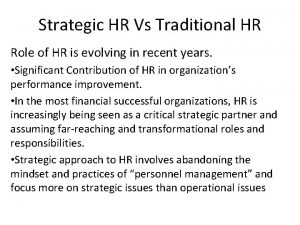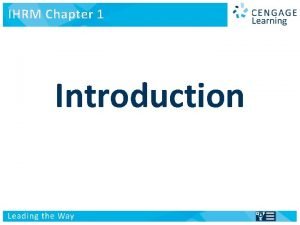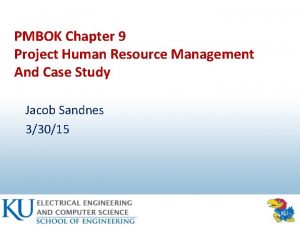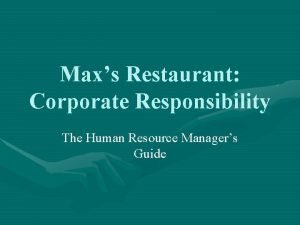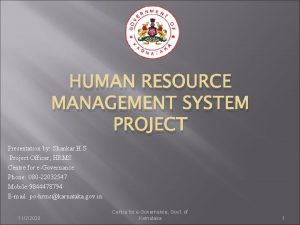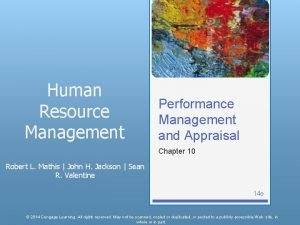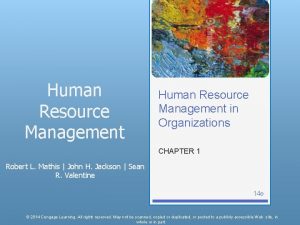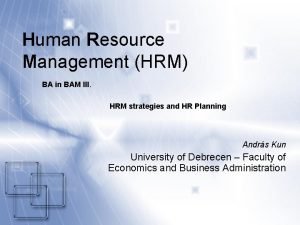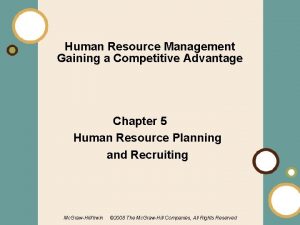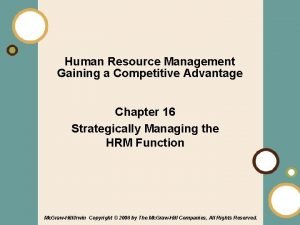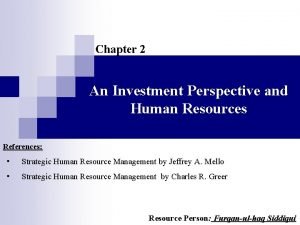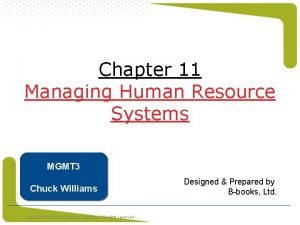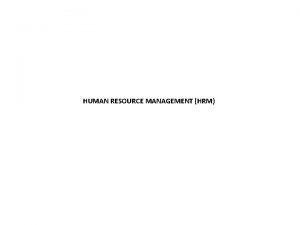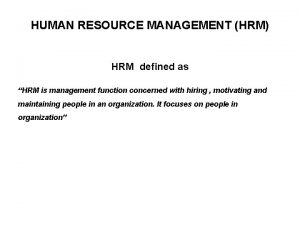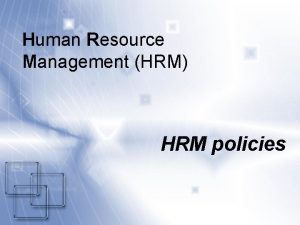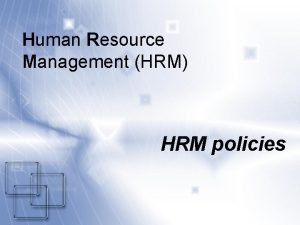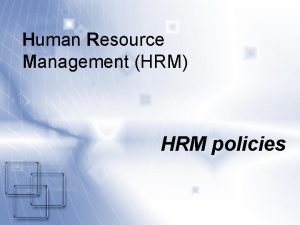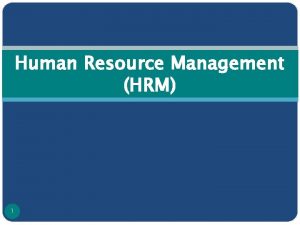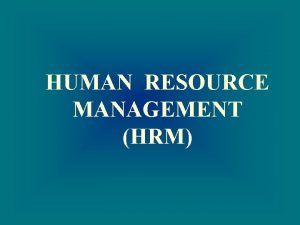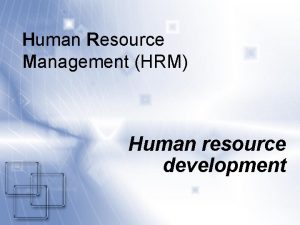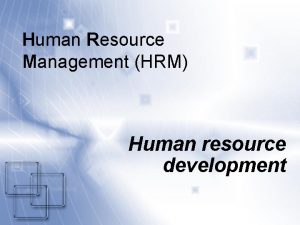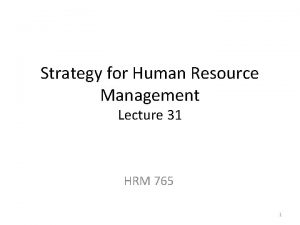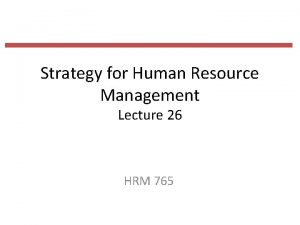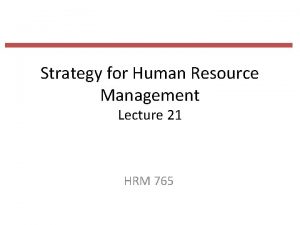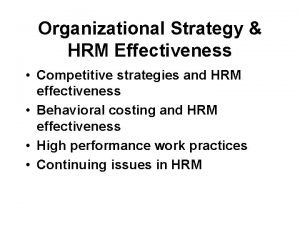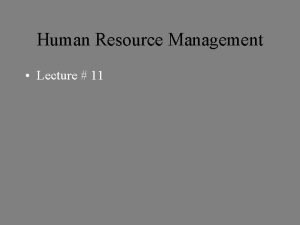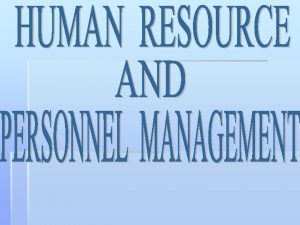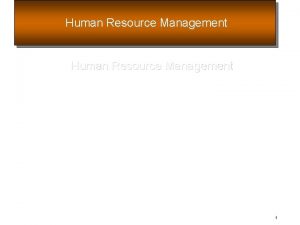Strategy for Human Resource Management Lecture 20 HRM
































- Slides: 32

Strategy for Human Resource Management Lecture 20 HRM 765

Last Lecture • Career Stages • Exploration---establishment--mid career—late career--decline Holland Vocational Preferences • Three major components – People have varying occupational preferences – If you think your work is important, you will be a more productive employee – You will have more in common with people who have similar interest patterns • Holland Vocational Preferences (Six) • Career Choices and Preferences • MBTI personality type. Fundamentals of Human Resource Management 8 e, De. Cenzo and Robbins

Topic Establishing the Performance Management System Fundamentals of Human Resource Management 8 e, De. Cenzo and Robbins

Learning Outcomes After reading this chapter, you will be able to: • • • Identify the three purposes of performance management systems and whom they serve. Explain the six steps in the appraisal process. Discuss absolute standards in performance management systems. Describe relative standards in performance management systems. Discuss how management by objective (MBO) can be used as an appraisal method. Explain why performance appraisals might be distorted. Identify ways to make performance management systems more effective. Describe the term 360 -degree appraisal. Explain the criteria for a successful performance appraisal meeting. Discuss how performance appraisals may differ in a global environment. Fundamentals of Human Resource Management 8 e, De. Cenzo and Robbins

HRM Process Fundamentals of Human Resource Management 8 e, De. Cenzo and Robbins

Employee Performance Management • Performance Management System – A process of establishing performance standards and appraising employee performance in order to arrive at objective HR decisions and to provide documentation in support of those decisions. Fundamentals of Human Resource Management 8 e, De. Cenzo and Robbins

Introduction • Employees generally see performance evaluations as having a direct effect on their work lives. • The performance management systems need to include: – decisions about who should evaluate performance – what format should be used – how the results should be utilized Fundamentals of Human Resource Management 8 e, De. Cenzo and Robbins

Checklist for customer relationship officer Fundamentals of Human Resource Management 8 e, De. Cenzo and Robbins

Performance Management Systems Purposes of a Performance Management System – Feedback - let employees know how well they have done and allow for employee input. – Development – identify areas in which employees have deficiencies or weaknesses. – Documentation - to meet legal requirements. Fundamentals of Human Resource Management 8 e, De. Cenzo and Robbins

Performance Management Systems Difficulties in Performance Management Systems – Focus on the individual: Discussions of performance may elicit strong emotions and may generate conflicts when subordinates and supervisors do not agree. Fundamentals of Human Resource Management 8 e, De. Cenzo and Robbins

Performance Management Systems Difficulties in Performance Management Systems – Focus on the process: Company policies and procedures may present barriers to a properly functioning appraisal process. – Additionally, appraisers may be poorly trained. Fundamentals of Human Resource Management 8 e, De. Cenzo and Robbins

Performance Management and EEO • HRM practices must be bias free, objective and job-related. • Valid performance appraisals are conducted at established intervals and are done by trained appraisers. Fundamentals of Human Resource Management 8 e, De. Cenzo and Robbins

The Appraisal Process Fundamentals of Human Resource Management 8 e, De. Cenzo and Robbins

The Appraisal Process • Establishment of performance standards – Derived from company’s strategic goals. – Based on job analysis and job description. • Communication of performance standards to employee. Fundamentals of Human Resource Management 8 e, De. Cenzo and Robbins

The Appraisal Process • Measurement of performance using information from: – personal observation – statistical reports – oral reports – written reports • Comparison of actual performance with standards. Fundamentals of Human Resource Management 8 e, De. Cenzo and Robbins

The Appraisal Process • Discussion of appraisal with employee. • Identification of corrective action where necessary. – Immediate action deals with symptoms. – Basic corrective action deals with causes. Fundamentals of Human Resource Management 8 e, De. Cenzo and Robbins

Appraisal Methods Three approaches: • Absolute standards • Relative standards • Objectives Fundamentals of Human Resource Management 8 e, De. Cenzo and Robbins

Appraisal Methods Evaluating absolute standards: • An employee’s performance is measured against established standards. • Evaluation is independent of any other employee. Fundamentals of Human Resource Management 8 e, De. Cenzo and Robbins

Appraisal Methods Evaluating absolute standards: – Essay Appraisal: Appraiser writes narrative describing employee performance & suggestions. – Critical Incident Appraisal: Based on key behavior, illustrating effective or ineffective job performance. Fundamentals of Human Resource Management 8 e, De. Cenzo and Robbins

Appraisal Methods Evaluating absolute standards: – Checklist Appraisal: Appraiser checks off behaviors that apply to the employee. – Adjective Rating Scale Appraisal: Appraiser rates employee on a number of jobrelated factors. Fundamentals of Human Resource Management 8 e, De. Cenzo and Robbins

Appraisal Methods Evaluating absolute standards: – Forced-Choice Appraisal: Appraisers choose from sets of statements which appear to be equally favorable, the statement which best describes the employee. Fundamentals of Human Resource Management 8 e, De. Cenzo and Robbins

Appraisal Methods Evaluating absolute standards: • Behaviorally Anchored Rating Scales (BARS): Appraiser rates employee on factors which are defined by behavioral descriptions illustrating various dimensions along each rating scale. Fundamentals of Human Resource Management 8 e, De. Cenzo and Robbins

Behaviorally Anchored Rating Scales (BARS) Fundamentals of Human Resource Management 8 e, De. Cenzo and Robbins

Graph Rating Scale Fundamentals of Human Resource Management 8 e, De. Cenzo and Robbins

Appraisal Methods Relative standards: • Employees are evaluated by comparing their performance to the performance of other employees. Fundamentals of Human Resource Management 8 e, De. Cenzo and Robbins

Appraisal Methods Relative standards: • Group Order Ranking: Employees are placed in a classification reflecting their relative performance, such as “top onefifth. ” Fundamentals of Human Resource Management 8 e, De. Cenzo and Robbins

Appraisal Methods Relative standards: – Individual Ranking: Employees are ranked from highest to lowest. – Paired Comparison: • Each individual is compared to every other. • Final ranking is based on number of times the individual is preferred member in a pair. Fundamentals of Human Resource Management 8 e, De. Cenzo and Robbins

Appraisal Methods Using Achieved Outcomes to Evaluate Employees Management by Objectives (MBO) A management model that aims to improve performance of an organization by clearly defining objectives that are agreed to by both management and the employee. – includes mutual objective setting and evaluation based on the attainment of the specific objectives Fundamentals of Human Resource Management 8 e, De. Cenzo and Robbins

Appraisal Methods Using Achieved Outcomes to Evaluate Employees – Common elements in an MBO program are: • • goal specificity participative decision making an explicit time period performance feedback – Effectively increases employee performance and organizational productivity. Fundamentals of Human Resource Management 8 e, De. Cenzo and Robbins

360 Degree Evaluation • Feedback that comes from members of an employee's immediate work circle. • Boss, subordinate, peer. Fundamentals of Human Resource Management 8 e, De. Cenzo and Robbins

Method Advantage Disadvantage Written essays Simple to use More a measure of evaluator’s writing ability than of employee’s actual performance Critical incidents Rich examples; behaviorally based Time-consuming; lack quantification Graphic rating scales Provide quantitative data; less time-consuming than others Do not provide depth of job behavior assessed BARS Focus on specific and measurable job behaviors Time-consuming; difficult to develop Multiperson comparisons Compares employees with one another Unwieldy with large number of employees; legal concerns MBO Focuses on end goals; results oriented Time-consuming 360 -degree appraisals Thorough Time-consuming Fundamentals of Human Resource Management 8 e, De. Cenzo and Robbins

Summary • Performance Management System • The performance management systems need to include: – – – decisions about who should evaluate performance what format should be used how the results should be utilized • The Appraisal Process • Difficulties in Performance Management Systems Three approaches: • Absolute standards • Relative standards • Objectives Fundamentals of Human Resource Management 8 e, De. Cenzo and Robbins
 Human resource management lecture chapter 1
Human resource management lecture chapter 1 Chapter 1 introduction to human resource management
Chapter 1 introduction to human resource management Human resource management lecture chapter 1
Human resource management lecture chapter 1 Human resource management strategy and analysis
Human resource management strategy and analysis Time management human resources
Time management human resources Human resource management in retailing
Human resource management in retailing Hrm vs hrd
Hrm vs hrd Traditional hr approach
Traditional hr approach Difference between domestic hrm and ihrm
Difference between domestic hrm and ihrm 01:640:244 lecture notes - lecture 15: plat, idah, farad
01:640:244 lecture notes - lecture 15: plat, idah, farad Resource management pmp
Resource management pmp Pmbok human resource management
Pmbok human resource management Important of human resource
Important of human resource Restaurant human resources
Restaurant human resources Human resource planning and retention
Human resource planning and retention Human resource management chapter 2
Human resource management chapter 2 Chapter 9 human resource management
Chapter 9 human resource management Human resource management system project ppt
Human resource management system project ppt Performance appraisal in human resource management
Performance appraisal in human resource management Current issues in human resource management
Current issues in human resource management Ba human resource management
Ba human resource management Higher business technology in human resources
Higher business technology in human resources Human resource management gaining a competitive advantage
Human resource management gaining a competitive advantage Human resource management gaining a competitive advantage
Human resource management gaining a competitive advantage Human resource management gaining a competitive advantage
Human resource management gaining a competitive advantage Exam questions on human resource management
Exam questions on human resource management Performance appraisal in human resource management
Performance appraisal in human resource management Hr proficiencies
Hr proficiencies Utilitarian organization
Utilitarian organization Chapter 11 human resource management
Chapter 11 human resource management Human resource management chapter 1
Human resource management chapter 1 Applied psychology in human resource management
Applied psychology in human resource management Nature of hrm
Nature of hrm







